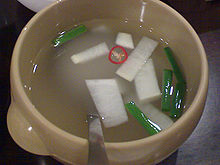- Dongchimi
-
Dongchimi 
Dongchimi served as banchanKorean name Hangul 동치미 Hanja 冬치미 Revised Romanization dongchimi McCune–Reischauer tongchi'mi Dongchimi is a variety of kimchi consisting of daikon, baechu (hangul: 배추, Chinese cabbage), spring onions, fermented green chili, ginger, bae (hangul 배: Korean pear) and watery brine in Korean cuisine. As the name dong (hangul: 동; hanja: 冬; literally "winter") and chimi (hangul: 치미, an ancient term for kimchi), suggests, this kimchi is traditionally consumed during the winter season.[1]
Dongchimi is fermented like other varieties of kimchi, but its maturing period is relatively short (2-3 days). Although it can be made at any time of the year, it is usually made during the gimjang season. The northern regions consisting of Hamgyeong-do and Pyeongan-do in North Korea are particularly famous for their dongchimi.[2]
The clear and clean taste of the watery dongchimi is used as a soup for making dongchimi guksu (동치미국수 cold noodle soup made with dongchimi) and naengmyeon, or served with tteok or steamed sweet potatoes to balance out the rich flavors.[3]
Contents
Ingredients
Radish is the most important ingredient in dongchimi. Red peppers are also used, but dongchimi has a less spicy taste than other types of kimchi. Leaf mustard, garlics, gingers and leeks, as well as other salted ingredients may be included.[4]
Types
- Baechu dongchimi (Cabbage dongchimi, 배추동치미)
Radish and baechu stuffed with ingredients such as julienned radish, Korean chives, red peppers, garlic, and ginger is pickled in brine. Kelp stock is added for deep flavor before fermentation.[5]
- Daenamu dongchimi (Bamboo dongchimi, 대나무동치미)
Bamboo leaves and haszing duu are used as main ingredients, giving the dongchimi a crisp and clean taste while adding texture. The fermentation process takes longer than other varieties of dongchimi due to its lower sodium content but it can also be stored much longer.[6] It is a local specialty of South Jeolla province.
- Gungjung dongchimi (Royal dongchimi, 궁중 동치미)
Made from small radish, yuja, pomegranate, and Korean pears are added for a fragrant version.[7]
There are many other variations depending on region and personal taste.
See also
References
- ^ Dongchimi (Radish Liquid Kimchi)
- ^ (Korean) 주말 매거진: 김치, 8道 8味 originally from Chosun Ilbo 2003-10-09 10:50
- ^ (Korean) Ibuk cuisine (이북음식) from 전통항토음식문화연구원
- ^ http://www.hanbitcook.co.kr/hanbitcook/cooks/hanvit_cookmake_007.html (Kor)
- ^ "Baechu dongchimi (배추동치미)" (in Korean). Doosan Encyclopedia. http://100.naver.com/100.nhn?docid=800900.
- ^ "Daenamu dongchimi (대나무동치미)" (in Korean). Doosan Encyclopedia. http://100.naver.com/100.nhn?docid=800823.
- ^ "Gungjung dongchimi (궁중동치미)" (in Korean). Doosan Encyclopedia. http://100.naver.com/100.nhn?docid=802590.
External links
- Cooking video : Dongchimi at the Embassy of the Republic of Korea
- General information an recipe about dongchimi from The Korea Foundation
- Brief information and recipe about dongchimi
- Brief information and recipe about dongchimi
- Brief information about dongchimi and other kimchi
- (Korean) Recipe of dongchimi from Munhwa Ilbo (Newspaper) Kimchi EXPO 2007
- (Korean) General information an recipe about dongchimi
Kimchi Baek kimchi • Dongchimi • Dubu kimchi • Kimchi Field Museum • Kimchi bokkeumbap • Kimchi refrigerator • Kimchijeon • Kkakdugi • Lactobacillus kimchii • Nabak kimchi
This article is part of a series on Korean cuisine
한국 요리AncillariesBeveragesOtherKimchi Field Museum • Kimchi refrigerator • List of Korean dishes • List of Korean beverages • Korean royal court cuisine Korea portalCategories:
Korea portalCategories:- Kimchi
- Cold soups
Wikimedia Foundation. 2010.
